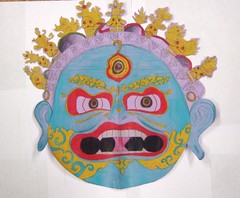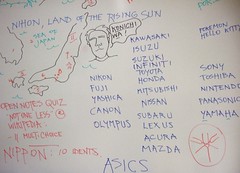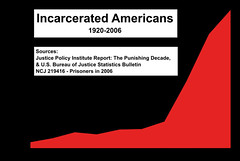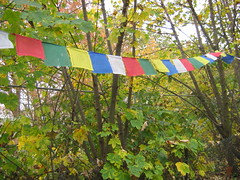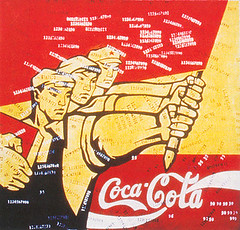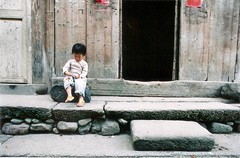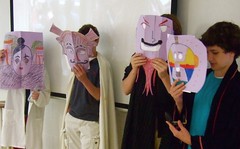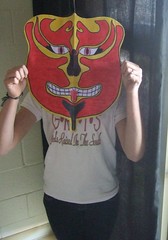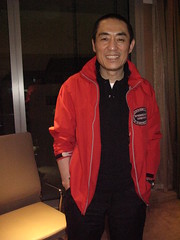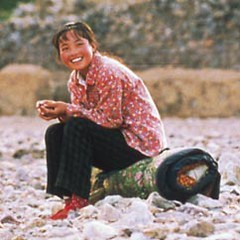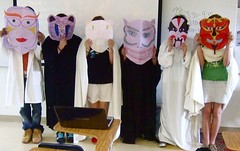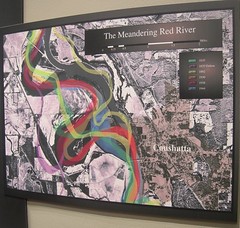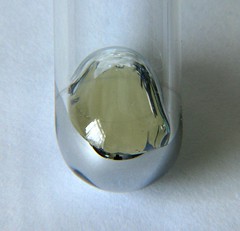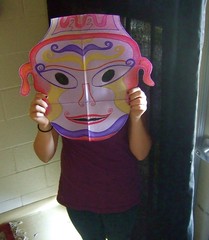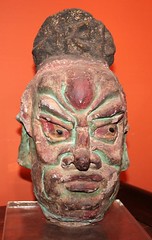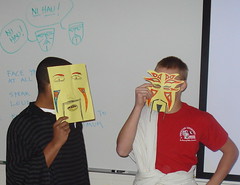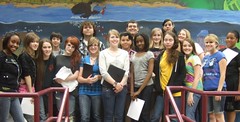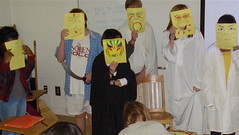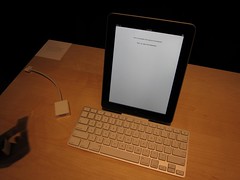This essay was written by award-winning social studies student Kristi Tso.
As a 13 year old substitute, Wei has to try to keep all 28 of her students from running away in the movie "Not One Less." But trying to do so has been a much harder job than she had expected. You might ask why does this matter to her. It matters to her because if she is able to do so, she will be given an extra 10 yuan on top of the 50 yuan that she is earning for subbing for a month. Although 10 yuan is equal to about $10 USD, it is a lot of money in the poor economy of China.
With students that don't really care for an education, she has to try extra hard to keep them in school. But with a student who is talented in running (being able to run fast), she has run into an obstacle having to try to keep her in school, but eventually she isn't able to keep her. With already one lose, she doesn't believe that she will get the extra 10 yuan, but because the mayor and coach said that they'll talk to Teacher Gao and that he wouldn't be angry but instead proud. Now with another student running away to the city to try to earn money in their hard economy, she has to try hard to earn enough money to get to the city and back with the student, Zhang Huike. While trying to find ways to earn money, she is able to teach her students basic mathmatetics without even trying. But since the the fare is way too high and they can't earn even money, that doesn't stop her. While trying to find ways to earn money, she is able to teach her students basic mathmatetics without even trying. She walks most of the way to the city, hitching a few rides there, taking a whole day. Even though when she gets there and cannot find him with the group he came with, she doesn't quit looking, but instead becomes stubborn, not giving up.
Friday, April 30, 2010
Thursday, April 29, 2010
A quiz on the Odyssey of a Chinese Teen in Not One Less
The Odyssey of a Chinese Teen
1. The film addresses the ______ gap between urban and rural populations. a) cultural b) economic c) legislative d) language.
2. Given the following bureaucrats: the Mayor, the brick factory manager, the clerk at the TV station, the TV station manager and the restaurant manager, we should conclude that the movie's director sees bureaucrats as mostly negative forces. T / F
3. The film primarily addresses this issue: a) history of China b) poverty in China c) rural education d) difficulty of life in the cities.
4. Which one of these characters is not battling the drop-out problem? a) Teacher Gao b) the Mayor c) Teacher Wei d) Zhang Huike.
5. Which one of these characters seems to provide a sense of balance and moderation? a) Teacher Gao b) the Mayor c) Teacher Wei d) Zhang Huike.
6. Which one of these characters is the most frugal? a) Teacher Gao b) the Mayor c) Teacher Wei d) Zhang Huike.
7. Which one of these characters shows heroic obstinacy? a) Teacher Gao b) the Mayor c) Teacher Wei d) Zhang Huike.
8. Shuixian School is located near the city of a) Hong Kong b) Xi’an c) Beijing d) Shanghai.
9. Is the mass media portrayed as a benign or a destructive force in China? The movie seems to say the news media is a) positive b) negative c) not a major factor.
10. A symbol of pride in learning and in the efficient use of resources in the school is: a) sending swift runner of the class to the sports specialty school b) flag c) chalk d) singing the anthem in an orderly formation.
11. "Keeping kids in school is harder than teaching them." Quote from a) the Mayor b) Substitute Wei c) Teacher Gao d) Zhang Huike.
12. Concerns about _____ dominate most of the characters and much of the film. a) ethics b) honor c) culture d) money.
1. The film addresses the ______ gap between urban and rural populations. a) cultural b) economic c) legislative d) language.
2. Given the following bureaucrats: the Mayor, the brick factory manager, the clerk at the TV station, the TV station manager and the restaurant manager, we should conclude that the movie's director sees bureaucrats as mostly negative forces. T / F
3. The film primarily addresses this issue: a) history of China b) poverty in China c) rural education d) difficulty of life in the cities.
4. Which one of these characters is not battling the drop-out problem? a) Teacher Gao b) the Mayor c) Teacher Wei d) Zhang Huike.
5. Which one of these characters seems to provide a sense of balance and moderation? a) Teacher Gao b) the Mayor c) Teacher Wei d) Zhang Huike.
6. Which one of these characters is the most frugal? a) Teacher Gao b) the Mayor c) Teacher Wei d) Zhang Huike.
7. Which one of these characters shows heroic obstinacy? a) Teacher Gao b) the Mayor c) Teacher Wei d) Zhang Huike.
8. Shuixian School is located near the city of a) Hong Kong b) Xi’an c) Beijing d) Shanghai.
9. Is the mass media portrayed as a benign or a destructive force in China? The movie seems to say the news media is a) positive b) negative c) not a major factor.
10. A symbol of pride in learning and in the efficient use of resources in the school is: a) sending swift runner of the class to the sports specialty school b) flag c) chalk d) singing the anthem in an orderly formation.
11. "Keeping kids in school is harder than teaching them." Quote from a) the Mayor b) Substitute Wei c) Teacher Gao d) Zhang Huike.
12. Concerns about _____ dominate most of the characters and much of the film. a) ethics b) honor c) culture d) money.
Wednesday, April 28, 2010
Grab some chopsticks and bring them to class on Tues
Geo students will make mini rock garden rakes by cutting and gluing pieces of chopsticks in class on Tues.
Zen Buddhist monks rake the gravel or sand in Japanese rock gardens each day. Ordinary Japanese people also have raked dry gardens.
The Japanese rock gardens (karesansui) or "dry landscape" gardens, often called "Zen gardens" were influenced mainly by Zen Buddhism and can be found at Zen temples of meditation, says Wikipedia.
Japanese gardens are a living work of art in which the plants and trees are ever changing with the seasons. As they grow and mature, they are constantly sculpted to maintain and enhance the overall experience; hence, a Japanese garden is never the same and never really finished.
The underlying structure of a Japanese garden is determined by the buildings, verandas and terraces, paths, tsukiyama (artificial hills), and stone compositions. Over time, it is only as good as the careful maintenance that it receives by those skilled in the art of training and pruning. Part of the art is to keep the garden almost still, like a painting.
Karesansui gardens can be extremely abstract and represent (miniature) landscapes also called "mind-scapes". This Buddhist preferred way to express cosmic beauty in worldly environments is inextricable from Zen Buddhism.
Zen Buddhist monks rake the gravel or sand in Japanese rock gardens each day. Ordinary Japanese people also have raked dry gardens.
The Japanese rock gardens (karesansui) or "dry landscape" gardens, often called "Zen gardens" were influenced mainly by Zen Buddhism and can be found at Zen temples of meditation, says Wikipedia.
Japanese gardens are a living work of art in which the plants and trees are ever changing with the seasons. As they grow and mature, they are constantly sculpted to maintain and enhance the overall experience; hence, a Japanese garden is never the same and never really finished.
The underlying structure of a Japanese garden is determined by the buildings, verandas and terraces, paths, tsukiyama (artificial hills), and stone compositions. Over time, it is only as good as the careful maintenance that it receives by those skilled in the art of training and pruning. Part of the art is to keep the garden almost still, like a painting.
Karesansui gardens can be extremely abstract and represent (miniature) landscapes also called "mind-scapes". This Buddhist preferred way to express cosmic beauty in worldly environments is inextricable from Zen Buddhism.
This weekend: Artbreak, Night of One-Acts, Relay for Life
Recommended this weekend -
a) Artbreak: S'port Convention Center, Ap 30 - May 2
b) Magnet Drama Dept's Night of One-Acts, Fri, Ap 3o, 6:30 pm
c) Relay for Life / Am Cancer Society benefit @ Lee Hedges Stadium,
Fri, Ap 30, all night.
Music, food, walking, jogging, etc.
a) Artbreak: S'port Convention Center, Ap 30 - May 2
b) Magnet Drama Dept's Night of One-Acts, Fri, Ap 3o, 6:30 pm
c) Relay for Life / Am Cancer Society benefit @ Lee Hedges Stadium,
Fri, Ap 30, all night.
Music, food, walking, jogging, etc.
Drop outs often find their way into the criminal justice sustem
The United States has the highest documented incarceration rate in the world, says Wikipedia.
The USA also has the highest total documented prison and jail population in the world.[1][4][5]
2,304,115 people were incarcerated in U.S. prisons and jails in 2008.[3][7] In addition, according to a December 2009 BJS report, there were 92,854 held in juvenile facilities.
The USA also has the highest total documented prison and jail population in the world.[1][4][5]
2,304,115 people were incarcerated in U.S. prisons and jails in 2008.[3][7] In addition, according to a December 2009 BJS report, there were 92,854 held in juvenile facilities.
Not One Less quiz on Thurs: see previous questions on this site
An earlier post on MondoTrudeau offered some 19 questions to guide you in watching the movie. Please add those questions to your material for the quiz on Thurs.
Constructed response to the list of Japanese companies
Constructed response:
What is the larger significance of the 3 columns of Japanese product names on the board?
Answer: It is apparent that the Japanese have had a huge impact on the US and the world through the success of their consumer goods. From Sony to Honda, these companies are among the most trusted and valued in American life.
What is the larger significance of the 3 columns of Japanese product names on the board?
Answer: It is apparent that the Japanese have had a huge impact on the US and the world through the success of their consumer goods. From Sony to Honda, these companies are among the most trusted and valued in American life.
Tuesday, April 27, 2010
Making Tibetan Buddhist flags in geography class on Thurs
Please make sure you have colors with you on Thurs. After the quizzes we will make paper Tibetan Buddhist flags.
A prayer flag is a colorful panel or rectangular cloth often found strung along mountain ridges and peaks high in the Himalayas to bless the surrounding countryside or for other purposes, says Wikipedia.
There are two kinds of prayer flags: horizontal ones, called lung ta (meaning "Wind Horse") in Tibetan, and the vertical Darchor. "Dar" translates as "to increase life, fortune, health and wealth", "Cho" translates as "all sentient beings".[1]
Traditionally, prayer flags are used to promote peace, compassion, strength, and wisdom. The flags do not carry prayers to 'gods,' a common misconception; rather, the Tibetans believe the prayers and mantras will be blown by the wind to spread the good will and compassion into all pervading space. Therefore, prayer flags are thought to bring benefit to all.
Lung Ta (horizontal) prayer flags are of square or rectangular shape and are connected along their top edges to a long string or thread. They are commonly hung on a diagonal line from high to low between two objects (e.g., a rock and the top of a pole) in high places such as the tops of temples, monasteries, stupas or mountain passes.
Traditionally, prayer flags come in sets of five, one in each of five colors. The five colors represent the elements,[1] and the Five Pure Lights and are arranged from left to right in a specific order. Different elements are associated with different colors for specific traditions, purposes and sadhana:
* Blue (symbolizing sky/space)
* White (symbolizing air/wind)
* Red (symbolizing fire)
* Green (symbolizing water)
* Yellow (symbolizing earth)[1]
The center of a prayer flag traditionally features a "Ta" (powerful or strong horse) bearing three flaming jewels (specifically ratna) on its back. The Ta is a symbol of speed and the transformation of bad fortune to good fortune. The three flaming jewels symbolize the Buddha, the Dharma (Buddhist teachings), and the Sangha (Buddhist community), the three cornerstones of Tibetan philosophical tradition.
Surrounding the Ta are various versions of approximately 400 traditional mantras (powerful ritual utterances).
A prayer flag is a colorful panel or rectangular cloth often found strung along mountain ridges and peaks high in the Himalayas to bless the surrounding countryside or for other purposes, says Wikipedia.
There are two kinds of prayer flags: horizontal ones, called lung ta (meaning "Wind Horse") in Tibetan, and the vertical Darchor. "Dar" translates as "to increase life, fortune, health and wealth", "Cho" translates as "all sentient beings".[1]
Traditionally, prayer flags are used to promote peace, compassion, strength, and wisdom. The flags do not carry prayers to 'gods,' a common misconception; rather, the Tibetans believe the prayers and mantras will be blown by the wind to spread the good will and compassion into all pervading space. Therefore, prayer flags are thought to bring benefit to all.
Lung Ta (horizontal) prayer flags are of square or rectangular shape and are connected along their top edges to a long string or thread. They are commonly hung on a diagonal line from high to low between two objects (e.g., a rock and the top of a pole) in high places such as the tops of temples, monasteries, stupas or mountain passes.
Traditionally, prayer flags come in sets of five, one in each of five colors. The five colors represent the elements,[1] and the Five Pure Lights and are arranged from left to right in a specific order. Different elements are associated with different colors for specific traditions, purposes and sadhana:
* Blue (symbolizing sky/space)
* White (symbolizing air/wind)
* Red (symbolizing fire)
* Green (symbolizing water)
* Yellow (symbolizing earth)[1]
The center of a prayer flag traditionally features a "Ta" (powerful or strong horse) bearing three flaming jewels (specifically ratna) on its back. The Ta is a symbol of speed and the transformation of bad fortune to good fortune. The three flaming jewels symbolize the Buddha, the Dharma (Buddhist teachings), and the Sangha (Buddhist community), the three cornerstones of Tibetan philosophical tradition.
Surrounding the Ta are various versions of approximately 400 traditional mantras (powerful ritual utterances).
Monday, April 26, 2010
The NY Times describes 36 hours in Kyoto, the imperial capital of Japan
The NY Times travel story by Jaime Gross opens thusly -
KYOTO, the former imperial capital of Japan, is a vibrant mash-up, an ancient city electrified by the breathtakingly new. Cruise the futuristic food halls of a department store, gaping at the perfect fruit and glistening sea creatures, before zipping up to the traditional floor, with its kimonos and tea ceremony implements.
See 2,000 ancient temples and shrines, then dine at a sleekly modern restaurant. Glimpse a geisha gliding down a cobblestone lane, bracketed by wooden machiya houses, and feel yourself catapulted to the 18th century — until you see her duck into a very 21st-century taxi, with a passenger door that opens and shuts automatically.
See more here.
KYOTO, the former imperial capital of Japan, is a vibrant mash-up, an ancient city electrified by the breathtakingly new. Cruise the futuristic food halls of a department store, gaping at the perfect fruit and glistening sea creatures, before zipping up to the traditional floor, with its kimonos and tea ceremony implements.
See 2,000 ancient temples and shrines, then dine at a sleekly modern restaurant. Glimpse a geisha gliding down a cobblestone lane, bracketed by wooden machiya houses, and feel yourself catapulted to the 18th century — until you see her duck into a very 21st-century taxi, with a passenger door that opens and shuts automatically.
See more here.
Product placement in Not One Less: Coca-Cola China
Coca-Cola is a carbonated soft drink sold in stores, restaurants, and vending machines internationally. The Coca-Cola Company claims that the beverage is sold in more than 200 countries.[1] It is produced by The Coca-Cola Company in Atlanta, Georgia, and is often referred to simply as Coke, writes Wikipedia.
Originally intended as a patent medicine when it was invented in the late 19th century by John Pemberton, Coca-Cola was bought out by businessman Asa Griggs Candler, whose marketing tactics led Coke to its dominance of the world soft-drink market throughout the 20th century.
The first sales were at Jacob's Pharmacy in Atlanta, Georgia, on May 8, 1886.[8] It was initially sold as a patent medicine for five cents[9] a glass at soda fountains, which were popular in the United States at the time due to the belief that carbonated water was good for the health.[10] Pemberton claimed Coca-Cola cured many diseases, including morphine addiction, dyspepsia, neurasthenia, headache, and impotence.
Coca-Cola was sold in bottles for the first time in 1894. The first outdoor wall advertisement was painted in the same year in Cartersville, Georgia.[18] Cans of Coke first appeared in 1955.[19] The first bottling of Coca-Cola occurred in Vicksburg, Mississippi, at the Biedenharn Candy Company in 1891.
Pemberton called for five ounces of coca leaf per gallon of syrup, a significant dose; in 1891, Candler claimed his formula (altered extensively from Pemberton's original) contained only a tenth of this amount. Coca-Cola did once contain an estimated nine milligrams of cocaine per glass, but in 1903 it was removed.[31] Coca-Cola still contains coca flavoring.
Originally intended as a patent medicine when it was invented in the late 19th century by John Pemberton, Coca-Cola was bought out by businessman Asa Griggs Candler, whose marketing tactics led Coke to its dominance of the world soft-drink market throughout the 20th century.
The first sales were at Jacob's Pharmacy in Atlanta, Georgia, on May 8, 1886.[8] It was initially sold as a patent medicine for five cents[9] a glass at soda fountains, which were popular in the United States at the time due to the belief that carbonated water was good for the health.[10] Pemberton claimed Coca-Cola cured many diseases, including morphine addiction, dyspepsia, neurasthenia, headache, and impotence.
Coca-Cola was sold in bottles for the first time in 1894. The first outdoor wall advertisement was painted in the same year in Cartersville, Georgia.[18] Cans of Coke first appeared in 1955.[19] The first bottling of Coca-Cola occurred in Vicksburg, Mississippi, at the Biedenharn Candy Company in 1891.
Pemberton called for five ounces of coca leaf per gallon of syrup, a significant dose; in 1891, Candler claimed his formula (altered extensively from Pemberton's original) contained only a tenth of this amount. Coca-Cola did once contain an estimated nine milligrams of cocaine per glass, but in 1903 it was removed.[31] Coca-Cola still contains coca flavoring.
Thurs reading comprehension quiz on Not One Less and map quiz on Nippon
In preparation for the open notes quiz on Thurs, please print out or take notes on 3 sections of the material on Not One Less found on Wikipedia.
a) the intro
b) plot
c) themes
Map quiz on Nippon, the Land of the Rising Sun, aka Japan.
Use 10 identifications.
1. S Korea
2. China
3. Russia
4. Kyushu
5. Shikoku
6. Honshu
7. Hokkaido
8. Sea of Japan
9. Pacific
10. Nagasaki
11. Hiroshima
12. Kyoto
13. Tokyo
14. Mt Fuji (Fuji-san)
a) the intro
b) plot
c) themes
Map quiz on Nippon, the Land of the Rising Sun, aka Japan.
Use 10 identifications.
1. S Korea
2. China
3. Russia
4. Kyushu
5. Shikoku
6. Honshu
7. Hokkaido
8. Sea of Japan
9. Pacific
10. Nagasaki
11. Hiroshima
12. Kyoto
13. Tokyo
14. Mt Fuji (Fuji-san)
Friday, April 23, 2010
Vietnam vet interview: 15 pts / Book report: 20 pts
This weekend you should check to see whether you have filed your
1) 2nd sem book report (20 pts)
and / or
2) Vietnam veteran interview (15 pts)
on a Google Doc entitled Book Report (or the book title)
or Vietnam Vet (or something equivalent).
Both are required in this semester's average.
1) 2nd sem book report (20 pts)
and / or
2) Vietnam veteran interview (15 pts)
on a Google Doc entitled Book Report (or the book title)
or Vietnam Vet (or something equivalent).
Both are required in this semester's average.
Wednesday, April 21, 2010
The First Emperor Quiz
1. The life of Shi Huang Di: a) 1200 BCE b) 200 AD c) 200 BCE .
2. Shi Huang Di’s version of the Great Wall was called a “precursor” to the later Great Wall. Precursor means
a) earlier version b) smaller example c) moveable pointer.
3. A tomb may also be called a : a) monument b) mound c) subterranean
d) mausoleum.
4. As a ruthless autocrat the First Emperor banned writing by __. a) Lao Tzu b) Tao c) Buddha d) Confucius.
5. The importance of his reign is intact after 2 millennium. That would be some a) 2 hundred b) 2 thousand c) 2 million years.
6. As a young king, Huangdi began construction on a) roads b) canals c) obelisks d) his mausoleum.
7. When a youth becomes king he usually has a powerful member of the court who acts as his guide to decision-making. That person’s title? a) proxy b) consort c) regent d) caretaker.
8. Shi Huang Di’s period of rule was preceded by a period of civil war known as a) Troubles b) Confucian c) Primitive d) Warring states.
9. Shi Huang Di unified China economically by standardizing the Chinese units of measurements such as weights and measures, the currency, the length of the axles of carts (so every cart could run smoothly in the ruts of the new roads). He also standardized the writing. T / F
10. Shi Huang Di seriously sought the elixir of life, a magical potion which reputedly would enable him to achieve immortality.
What is an elixir? a) a pool of magical water b) alchemist's mixture c) health-giving drink d) hallucinogenic drug.
11. The huge terra cotta army buried with Shi Huang Di lies near which city? a) Beijing b) Shanghai c) Hong Kong d) Xi’an.
12. In one of his greatest construction projects, the Emperor Qin commanded the building of the Ling Qu __ .
a) bridge b) tunnel c) canal d) pagoda.
2. Shi Huang Di’s version of the Great Wall was called a “precursor” to the later Great Wall. Precursor means
a) earlier version b) smaller example c) moveable pointer.
3. A tomb may also be called a : a) monument b) mound c) subterranean
d) mausoleum.
4. As a ruthless autocrat the First Emperor banned writing by __. a) Lao Tzu b) Tao c) Buddha d) Confucius.
5. The importance of his reign is intact after 2 millennium. That would be some a) 2 hundred b) 2 thousand c) 2 million years.
6. As a young king, Huangdi began construction on a) roads b) canals c) obelisks d) his mausoleum.
7. When a youth becomes king he usually has a powerful member of the court who acts as his guide to decision-making. That person’s title? a) proxy b) consort c) regent d) caretaker.
8. Shi Huang Di’s period of rule was preceded by a period of civil war known as a) Troubles b) Confucian c) Primitive d) Warring states.
9. Shi Huang Di unified China economically by standardizing the Chinese units of measurements such as weights and measures, the currency, the length of the axles of carts (so every cart could run smoothly in the ruts of the new roads). He also standardized the writing. T / F
10. Shi Huang Di seriously sought the elixir of life, a magical potion which reputedly would enable him to achieve immortality.
What is an elixir? a) a pool of magical water b) alchemist's mixture c) health-giving drink d) hallucinogenic drug.
11. The huge terra cotta army buried with Shi Huang Di lies near which city? a) Beijing b) Shanghai c) Hong Kong d) Xi’an.
12. In one of his greatest construction projects, the Emperor Qin commanded the building of the Ling Qu __ .
a) bridge b) tunnel c) canal d) pagoda.
Tuesday, April 20, 2010
Not One Less created by one of China's most successful directors, Zhang Yimou
Zhang Yimou (born November 14, 1951) is an internationally acclaimed Chinese filmmaker and former cinematographer.
One of Zhang's recurrent themes is a celebration of the resilience, even the stubbornness, of Chinese people in the face of hardships and adversities, a theme which has occurred from To Live (1994) through to Not One Less (1999).
His works are particularly noted for their use of colour, as can be seen in his early trilogy (like Raise the Red Lantern) or in his wuxia films such as Hero and House of Flying Daggers.
One of Zhang's recurrent themes is a celebration of the resilience, even the stubbornness, of Chinese people in the face of hardships and adversities, a theme which has occurred from To Live (1994) through to Not One Less (1999).
His works are particularly noted for their use of colour, as can be seen in his early trilogy (like Raise the Red Lantern) or in his wuxia films such as Hero and House of Flying Daggers.
Final exam schedule May 25 - 27, 2010
Tues, May 25 -
- 8:30 - 8:40 / Ch One
- 8:45 - 10:30 / 3rd hr exam
- 10:30 - 10:40 / break
- 10:45 - 12:30 / 4th hr exam
- 12:30 students are dismissed to car pools
- 12:30 - 1:00 / lunch in cafeteria followed by bus pick up.
Wed, May 26
same as above
- 1st hr exam at 8:45
- 5th hr exam at 10:45
Thurs, May 27
- 2nd hr exam
- 6th hr exam
Students may not leave the classroom during exam testing periods.
Exam must count as 20% of semester grade.
Report cards will be mailed.
- 8:30 - 8:40 / Ch One
- 8:45 - 10:30 / 3rd hr exam
- 10:30 - 10:40 / break
- 10:45 - 12:30 / 4th hr exam
- 12:30 students are dismissed to car pools
- 12:30 - 1:00 / lunch in cafeteria followed by bus pick up.
Wed, May 26
same as above
- 1st hr exam at 8:45
- 5th hr exam at 10:45
Thurs, May 27
- 2nd hr exam
- 6th hr exam
Students may not leave the classroom during exam testing periods.
Exam must count as 20% of semester grade.
Report cards will be mailed.
Wei Minzhi in Zhang Yimou's movie Not One Less
Not One Less, a story of China
1) Not One Less is a movie whose dialogue is in a) Mandarin Chinese b) Cantonese Chinese c) Rural Chinese.
In the following prompts choose between a. Teacher Gao b) the Mayor c) Teacher Wei d) Zhang Huike.
2) Most frugal character.
3) Battling the drop-out rate.
4) Money conscious.
5) Menial work.
6) Moderating influence.
7) Strongest allegiance.
8) Stubborn.
9) Happy-go-lucky.
10) Philosophical and accepting.
11) Chinese currency: a) yuan b) yen c) Chinese dollar.
12) Shuixian School is located near a) Xi’an b) Beijing c) Shanghai.
13) Symbol of pride in learning and efficient use of resources in the school: a) sending swift runner of the class to the sports specialty school b) flag c) chalk.
14) Type of humor which crosses cultural borders: a) religious b) political c) scatalogical d) sarcasm.
15) The director of Not One Less: a) Jet Li b) Zhang Huike c) Zhang Yimou d) Shi Huang Di.
16) Substitute Wei is about age a) 12 b) 13 c) 15 d) 17.
17) Why do 5 students sleep in the schoolroom? a) they live too far away to walk to school each day b) saving their money for college
c) paying off family debt by work at the school.
18) "Keeping kids in school is harder than teaching them." Quote from
a) the mayor b) Wei c) Teacher Gao.
19) The manager of the brick factory donates money to Wei and her class and says, "Call me a philanthropist." a) Person who sees the bad in life but tries to remain good. b) Person who is philosophical about life c) Person who gives generously to public causes.
1) Not One Less is a movie whose dialogue is in a) Mandarin Chinese b) Cantonese Chinese c) Rural Chinese.
In the following prompts choose between a. Teacher Gao b) the Mayor c) Teacher Wei d) Zhang Huike.
2) Most frugal character.
3) Battling the drop-out rate.
4) Money conscious.
5) Menial work.
6) Moderating influence.
7) Strongest allegiance.
8) Stubborn.
9) Happy-go-lucky.
10) Philosophical and accepting.
11) Chinese currency: a) yuan b) yen c) Chinese dollar.
12) Shuixian School is located near a) Xi’an b) Beijing c) Shanghai.
13) Symbol of pride in learning and efficient use of resources in the school: a) sending swift runner of the class to the sports specialty school b) flag c) chalk.
14) Type of humor which crosses cultural borders: a) religious b) political c) scatalogical d) sarcasm.
15) The director of Not One Less: a) Jet Li b) Zhang Huike c) Zhang Yimou d) Shi Huang Di.
16) Substitute Wei is about age a) 12 b) 13 c) 15 d) 17.
17) Why do 5 students sleep in the schoolroom? a) they live too far away to walk to school each day b) saving their money for college
c) paying off family debt by work at the school.
18) "Keeping kids in school is harder than teaching them." Quote from
a) the mayor b) Wei c) Teacher Gao.
19) The manager of the brick factory donates money to Wei and her class and says, "Call me a philanthropist." a) Person who sees the bad in life but tries to remain good. b) Person who is philosophical about life c) Person who gives generously to public causes.
Monday, April 19, 2010
Bonus credit for attending Shakespeare in the Centenary Band Shell on Th, Ap 22, Fri, Ap 23, 8 pm
The Tempest is a play by William Shakespeare about magic and about men stranded because of a shipwreck.
Performances of The Tempest by drama students at Centenary College are free to high school students on Th and Fri, Ap 22 - 23.
The site is outdoors; it is the Band Shell in the middle of the Centenary campus.
Bonus credit for attending!
More info from assistant professor of drama Emily Heugatter:
eheugatt@centenary.edu
Performances of The Tempest by drama students at Centenary College are free to high school students on Th and Fri, Ap 22 - 23.
The site is outdoors; it is the Band Shell in the middle of the Centenary campus.
Bonus credit for attending!
More info from assistant professor of drama Emily Heugatter:
eheugatt@centenary.edu
Week of Ap 18: Quiz on Wed and presentation on Fri: either Master Kung (Confucius) or Kublai Khan
Open notes quiz on Wed:
a) Qin Shi huang di
b) early Chinese technology
c) geography of China and East Asia from your atlas
No map quiz.
Research and production of a presentation on one of the figures below (Mon and Wed in lib) to be presented via a Google Doc on Fri:
a) the teachings of Confucius
b) the conquests of Kublai Khan
12 pts: include 6 images w bulleted info, including a map of China.
a) Qin Shi huang di
b) early Chinese technology
c) geography of China and East Asia from your atlas
No map quiz.
Research and production of a presentation on one of the figures below (Mon and Wed in lib) to be presented via a Google Doc on Fri:
a) the teachings of Confucius
b) the conquests of Kublai Khan
12 pts: include 6 images w bulleted info, including a map of China.
Sunday, April 18, 2010
Mapping Magnet High and the area
Creating mental maps of the community is an important function in developing thinking skills.
map (map), n., v. mapped, mapping, n. 1. a drawing representing selected features of the earth’s surface or part of it. 2. a map like drawing of anything: a highway way, a weather map. v. 1. to make a map of; show on a map. 2. to collect information for a map by exploring or surveying a region.
How does one describe an area to someone who needs that info? How does one get from place A to place B most efficiently? How does one plan landscaping and imagine gardens and pavilions for the future? How does one develop property and greenways? Is there a way to enrich your understanding of an area? Of finding an area's less-obvious value?
It begins with informal mapping. Sketching, measuring, thinking creatively about how to See and capture the essence of an area.
The activity moves to comparison and research: compare your drawings to published maps. Can you integrate the 2 versions? is there a way in which your informal map has value?
Sharing maps with each other and discussing ways to incorporate elements of each map in a larger collaborative map adds value to students' sense of space and geography.
Many of these maps will be more conceptual than realistic or geographically correct. The sketches and charts that will come from students offer value by showing how students and artists think and feel about their community.
Coming up after China: sketch maps of the campus.
map (map), n., v. mapped, mapping, n. 1. a drawing representing selected features of the earth’s surface or part of it. 2. a map like drawing of anything: a highway way, a weather map. v. 1. to make a map of; show on a map. 2. to collect information for a map by exploring or surveying a region.
How does one describe an area to someone who needs that info? How does one get from place A to place B most efficiently? How does one plan landscaping and imagine gardens and pavilions for the future? How does one develop property and greenways? Is there a way to enrich your understanding of an area? Of finding an area's less-obvious value?
It begins with informal mapping. Sketching, measuring, thinking creatively about how to See and capture the essence of an area.
The activity moves to comparison and research: compare your drawings to published maps. Can you integrate the 2 versions? is there a way in which your informal map has value?
Sharing maps with each other and discussing ways to incorporate elements of each map in a larger collaborative map adds value to students' sense of space and geography.
Many of these maps will be more conceptual than realistic or geographically correct. The sketches and charts that will come from students offer value by showing how students and artists think and feel about their community.
Coming up after China: sketch maps of the campus.
Thursday, April 15, 2010
Alchemists and mercury
Mercury, also quicksilver or hydrargyrum, is a chemical element with the symbol Hg (Latinized Greek: hydrargyrum, from "hydr-" meaning watery or runny and "argyros" meaning silver) and atomic number 80.
A heavy, silvery d-block metal, mercury is one of five metallic chemical elements that are liquid at or near room temperature and pressure, says Wikipedia.
Mercury occurs in deposits throughout the world mostly as cinnabar (mercuric sulfide), which is the source of the red pigment vermilion, and is mostly obtained by reduction from cinnabar. Cinnabar is highly toxic by ingestion or inhalation of the dust.
Mercury is used in thermometers, barometers, manometers, sphygmomanometers, float valves, and other scientific apparatus.
Mercury was found in Egyptian tombs that date from 1500 BC.[15] It was also known to the ancient Chinese.[16] In China and Tibet, mercury use was thought to prolong life, heal fractures, and maintain generally good health. One of China's emperors, Qín Shǐ Huáng Dì — allegedly buried in a tomb that contained rivers of flowing mercury on a model of the land he ruled, representative of the rivers of China — was killed by drinking a mercury and powdered jade mixture (causing liver failure, poisoning, and brain death) intended to give him eternal life.[17][18]
The ancient Greeks used mercury in ointments; the ancient Egyptians and the Romans used it in cosmetics which sometimes deformed the face. By 500 BC mercury was used to make amalgams with other metals.[19] The Indian word for alchemy is Rasavātam which means "the way of mercury".[20]
Alchemists thought of mercury as the First Matter from which all metals were formed. They believed that different metals could be produced by varying the quality and quantity of sulfur contained within the mercury. The purest of these was gold, and mercury was called for in attempts at the transmutation of base (or impure) metals into gold, which was the goal of many alchemists.[21]
A heavy, silvery d-block metal, mercury is one of five metallic chemical elements that are liquid at or near room temperature and pressure, says Wikipedia.
Mercury occurs in deposits throughout the world mostly as cinnabar (mercuric sulfide), which is the source of the red pigment vermilion, and is mostly obtained by reduction from cinnabar. Cinnabar is highly toxic by ingestion or inhalation of the dust.
Mercury is used in thermometers, barometers, manometers, sphygmomanometers, float valves, and other scientific apparatus.
Mercury was found in Egyptian tombs that date from 1500 BC.[15] It was also known to the ancient Chinese.[16] In China and Tibet, mercury use was thought to prolong life, heal fractures, and maintain generally good health. One of China's emperors, Qín Shǐ Huáng Dì — allegedly buried in a tomb that contained rivers of flowing mercury on a model of the land he ruled, representative of the rivers of China — was killed by drinking a mercury and powdered jade mixture (causing liver failure, poisoning, and brain death) intended to give him eternal life.[17][18]
The ancient Greeks used mercury in ointments; the ancient Egyptians and the Romans used it in cosmetics which sometimes deformed the face. By 500 BC mercury was used to make amalgams with other metals.[19] The Indian word for alchemy is Rasavātam which means "the way of mercury".[20]
Alchemists thought of mercury as the First Matter from which all metals were formed. They believed that different metals could be produced by varying the quality and quantity of sulfur contained within the mercury. The purest of these was gold, and mercury was called for in attempts at the transmutation of base (or impure) metals into gold, which was the goal of many alchemists.[21]
Wednesday, April 14, 2010
Creating a dramatic presentation on the Middle Kingdom and the first emperor, Qin Shihuangdi
Your script should mention -
- Welcome to the Middle Kingdom
- Ni hau! Xi'an, 200 BCE
- intro characters
- 5 achievements of Qin and / or the early Chinese
- Trouble in Paradise
- conflict: emperor desires to be immortal
- search for the elixir of eternal life
- The Ironic elixir
- emperor succumbs to his medicine
- burial
- 15 pts overall
Scripts and masks to be ready for in-class presentation on Friday.
- 5 pts mask that is large, colored
- 10 pts script and cues for beginning each line in turn.
Selected groups will be allowed to present their skit to Mr Flowers class on Mon.
- Welcome to the Middle Kingdom
- Ni hau! Xi'an, 200 BCE
- intro characters
- 5 achievements of Qin and / or the early Chinese
- Trouble in Paradise
- conflict: emperor desires to be immortal
- search for the elixir of eternal life
- The Ironic elixir
- emperor succumbs to his medicine
- burial
- 15 pts overall
Scripts and masks to be ready for in-class presentation on Friday.
- 5 pts mask that is large, colored
- 10 pts script and cues for beginning each line in turn.
Selected groups will be allowed to present their skit to Mr Flowers class on Mon.
Thursday, April 08, 2010
Chinese tombs and embalming
Please see
- More excavations of Qin's tomb.
- An embalmed noblewoman from over 2000 years ago: the Han Dynasty. She is called the Marquise of Dai.
- More excavations of Qin's tomb.
- An embalmed noblewoman from over 2000 years ago: the Han Dynasty. She is called the Marquise of Dai.
Wednesday, April 07, 2010
Map quiz followed by giant paper Chinese Mask making on Thurs
1. Map quiz on Chinese neighbors & cities - 11 items - on Thurs.
2. Colors, scissors, glue and creativity needed in the Chinese mask project. We will try to make masks that are double the size of masks made in prior geography classes. No; four times the size of the earlier creations.
2. Colors, scissors, glue and creativity needed in the Chinese mask project. We will try to make masks that are double the size of masks made in prior geography classes. No; four times the size of the earlier creations.
iLeap & GEE tests Mon - Wed, April 12 14, 8:30 am to noon
STUDENT RESPONSIBILITIES DURING TESTING WEEK
1.CELL PHONES AND CAMERAS ARE NOT ALLOWED IN TESTING ROOMS.
Please leave phones and cameras at home on test days.
2. Arrive on campus well before 8:25 a.m. Go directly to your test site by the time the 8:25 a.m. bell rings. Testing begins promptly at 8:30 a.m.
3. Schedule doctor/dentist appointments during the afternoons or during another week. It is important you be on campus every day during testing.
4. Get a good night’s sleep and eat a healthy breakfast on testing days.
5. Take only a library book to your testing site. YOU ARE NOT ALLOWED TO DO ANY COURSE CONTENT WORK WHILE IN THE TEST SITE AND TEXTBOOKS ARE NOT ALLOWED IN THE TEST SITE.
6. Leave backpacks in lockers or non-testing rooms.
7. 9th and 10th graders – Please bring a calculator you are comfortable using. iLEAP math test is Monday, and GEE21 math test is Tuesday.
8. Tests will end at different times each day and these times are unpredictable, so please bring your lunch or lunch money on test days to minimize disruptions.
9. Tuesday –Periods 1, 2 and 3 meet in the afternoon instead of periods 4, 5 and 6. If you have morning off-campus classes (CCTC, BTW, MCM), please check with your teachers concerning anything you may miss during classes held that afternoon, then report to your afternoon classes as usual. Morning program students report to E202 with Mrs. Martino (bring school work to work on). 6th hour off-campus P.E. students will tell their instructors that the altered schedule will cause them to miss off-campus PE on Tuesday.
Go to the lunch shift assigned to your 1st period teacher.
Monday – 4th-6th periods as usual, normal lunch shift.
Teachers will teach classes as usual during the afternoons of test days. Teachers have been asked not to assign major projects that are due during the testing week or give major tests on the state testing days. Short assignments, homework and quizzes may be given so come to afternoon classes prepared. Teachers of 10th and 11th graders may give tests on Wednesday, April 14. Seniors may be given tests at any time during testing week.
Students are to report to their assigned locations at 8:25 am on Monday, April 12 through Wednesday, April 14. Roll will be taken at the test sites/classrooms and reported to the school administrator assigned to collect attendance for each group. Testing will begin at 8:30 am. Lunch will be held until all groups have finished testing.
*Ninth and tenth grade students are to bring calculators that they are accustomed to using to math tests. Graphing calculators are allowed. Calculators with paper tape, writing pads or pen input devices, QWERTY keypads, or are part of laptop computers or pocket organizers are not allowed.
Approximate testing times
Monday, 4/12 8:25 – 12:15 pm 9th – Report to test sites for iLEAP Tests (Math)* -3 hrs 10th – Report to test sites for GEE 21 (ELA)-3.5 hrs
11th – Report to test sites for GEE 21 (Science)-2 hrs
12th – Report to the PAC
Afternoon – periods 4, 5, 6
Tuesday 4/13 8:25 –12:00 pm 9th – Report to test sites for iLEAP Tests (ELA)-2.5 hrs
10th – Report to test sites for GEE 21 (ELA, Math)*-3 hrs
11th – Report to test sites for GEE 21 (Soc. Studies)- 2 hrs
12th – Report to the PAC
Afternoon -1st (lunch according to this teacher’s regular shift), 2nd, and 3rd period classes - (CCTC, BTW, & MCM report to afternoon programs as usual after checking with morning teachers. CCTC and MCM morning students and 1st hour off campus PE students report to C9 with school work to do (monitored by Mrs. Martino). 6th hour off campus students should tell off-campus PE instructors they will miss the off-campus PE class that day due to our altered class schedule.
.
Wednesday, 4/14 8:25 – 10:45 pm 9th – Report to test sites for iLEAP Tests (ELA)-2 hrs 10th – Report to class sites for periods 1-2
11th – Report to class sites for periods 1-2
12th – Report to class sites for periods 1-2
Period 3 after testing is complete and periods 4, 5, 6 as usual.
In order to have students well rested and mentally prepared for these important tests, teachers are requested not to have projects due or give major tests during the times of testing for each grade. Class time in the afternoon should be used for instruction and class work. Short assignments may be given.
Students should take only a library book to the test site on the testing days. Students are not allowed to use textbooks or do homework while the testing materials are in the room. Instruct students to brig only the books, etc. necessary for the classes to be held that afternoon. Backpacks should be taken to the testing sites on test days. It is the responsibility of students in off campus programs to check with their teachers about assignments for the classed they miss due to testing.
1.CELL PHONES AND CAMERAS ARE NOT ALLOWED IN TESTING ROOMS.
Please leave phones and cameras at home on test days.
2. Arrive on campus well before 8:25 a.m. Go directly to your test site by the time the 8:25 a.m. bell rings. Testing begins promptly at 8:30 a.m.
3. Schedule doctor/dentist appointments during the afternoons or during another week. It is important you be on campus every day during testing.
4. Get a good night’s sleep and eat a healthy breakfast on testing days.
5. Take only a library book to your testing site. YOU ARE NOT ALLOWED TO DO ANY COURSE CONTENT WORK WHILE IN THE TEST SITE AND TEXTBOOKS ARE NOT ALLOWED IN THE TEST SITE.
6. Leave backpacks in lockers or non-testing rooms.
7. 9th and 10th graders – Please bring a calculator you are comfortable using. iLEAP math test is Monday, and GEE21 math test is Tuesday.
8. Tests will end at different times each day and these times are unpredictable, so please bring your lunch or lunch money on test days to minimize disruptions.
9. Tuesday –Periods 1, 2 and 3 meet in the afternoon instead of periods 4, 5 and 6. If you have morning off-campus classes (CCTC, BTW, MCM), please check with your teachers concerning anything you may miss during classes held that afternoon, then report to your afternoon classes as usual. Morning program students report to E202 with Mrs. Martino (bring school work to work on). 6th hour off-campus P.E. students will tell their instructors that the altered schedule will cause them to miss off-campus PE on Tuesday.
Go to the lunch shift assigned to your 1st period teacher.
Monday – 4th-6th periods as usual, normal lunch shift.
Teachers will teach classes as usual during the afternoons of test days. Teachers have been asked not to assign major projects that are due during the testing week or give major tests on the state testing days. Short assignments, homework and quizzes may be given so come to afternoon classes prepared. Teachers of 10th and 11th graders may give tests on Wednesday, April 14. Seniors may be given tests at any time during testing week.
Students are to report to their assigned locations at 8:25 am on Monday, April 12 through Wednesday, April 14. Roll will be taken at the test sites/classrooms and reported to the school administrator assigned to collect attendance for each group. Testing will begin at 8:30 am. Lunch will be held until all groups have finished testing.
*Ninth and tenth grade students are to bring calculators that they are accustomed to using to math tests. Graphing calculators are allowed. Calculators with paper tape, writing pads or pen input devices, QWERTY keypads, or are part of laptop computers or pocket organizers are not allowed.
Approximate testing times
Monday, 4/12 8:25 – 12:15 pm 9th – Report to test sites for iLEAP Tests (Math)* -3 hrs 10th – Report to test sites for GEE 21 (ELA)-3.5 hrs
11th – Report to test sites for GEE 21 (Science)-2 hrs
12th – Report to the PAC
Afternoon – periods 4, 5, 6
Tuesday 4/13 8:25 –12:00 pm 9th – Report to test sites for iLEAP Tests (ELA)-2.5 hrs
10th – Report to test sites for GEE 21 (ELA, Math)*-3 hrs
11th – Report to test sites for GEE 21 (Soc. Studies)- 2 hrs
12th – Report to the PAC
Afternoon -1st (lunch according to this teacher’s regular shift), 2nd, and 3rd period classes - (CCTC, BTW, & MCM report to afternoon programs as usual after checking with morning teachers. CCTC and MCM morning students and 1st hour off campus PE students report to C9 with school work to do (monitored by Mrs. Martino). 6th hour off campus students should tell off-campus PE instructors they will miss the off-campus PE class that day due to our altered class schedule.
.
Wednesday, 4/14 8:25 – 10:45 pm 9th – Report to test sites for iLEAP Tests (ELA)-2 hrs 10th – Report to class sites for periods 1-2
11th – Report to class sites for periods 1-2
12th – Report to class sites for periods 1-2
Period 3 after testing is complete and periods 4, 5, 6 as usual.
In order to have students well rested and mentally prepared for these important tests, teachers are requested not to have projects due or give major tests during the times of testing for each grade. Class time in the afternoon should be used for instruction and class work. Short assignments may be given.
Students should take only a library book to the test site on the testing days. Students are not allowed to use textbooks or do homework while the testing materials are in the room. Instruct students to brig only the books, etc. necessary for the classes to be held that afternoon. Backpacks should be taken to the testing sites on test days. It is the responsibility of students in off campus programs to check with their teachers about assignments for the classed they miss due to testing.
Bonus credit: attend the Magnet Choir's performance of the opera Dido & Aeneas on Th, or Fri, Ap 8, 9 at 6:30 pm
Mishael Womack, Maureen FitzGerald, Jessica Hensley, Lexi Ross and Andrew Lewis (l to r, photo) sing the lead roles in the Magnet Choir's presentation of the English opera Dido and Aeneas.
To be sung on Th and Fri, Ap 8, 9 at 6:30 pm in the Lecture Hall (adjacent to the band room and art rooms), space is limited. Tickets are $5.
Singers will be accompanied by a string quintet and harpsichord, says Jay Williams, choir director.
.
To be sung on Th and Fri, Ap 8, 9 at 6:30 pm in the Lecture Hall (adjacent to the band room and art rooms), space is limited. Tickets are $5.
Singers will be accompanied by a string quintet and harpsichord, says Jay Williams, choir director.
.
Tuesday, April 06, 2010
Qin Shi Huangdi review: the First Emperor and his reign
First emperor review . . .
1. The life of Shi Huang Di: a) 1200 BCE b) 200 BCE c) 200 AD d) it is fictitious.
2. Shi Huang Di’s version of the Great Wall was called a “precursor” to the later Great Wall. Precursor means
a) small version b) earlier example c) moveable pointer
3. Tomb: a) monument b) mound c) subterranean
d) mausoleum.
4. As an audacious autocrat the First Emperor burned and banned writing by __. a) Lao Tzu b) Tao c) Confucius d) Buddha.
5. The importance of his reign is intact after 2 millennium. That would be some a) 200 b) 2 thousand c) 2 million years.
6. As a young king, Huangdi began construction on a) roads b) canals c) obeisks d) his mausoleum.
7. When a youth becomes king he usually has a powerful member of the court who acts as his guide to decision-making. That person’s title? a) proxy b) consort c) regent d) caretaker.
8. Shi Huang Di’s period of rule was preceded by a period of civil war known as a) Warring states b) Confucian c) Primitive d) Troubles.
9. Shi Huang Di unified China economically by standardizing the Chinese units of measurements such as weights and measures, the currency, the length of the axles of carts (so every cart could run smoothly in the ruts of the new roads). He was not able to upgrade the legal system. T / F
10. What was his most important reform, according to Wikipedia?
a) silk b) currency c) writing d) elephants.
11. Shi Huang Di seriously sought the elixir of life, a magical potion which reputedly would enable immortality.
What is an elixir? a) health-giving drink b) magical cape or hat c) a pool of magical water d) hallucinogenic drug.
12. The huge terra cotta army buried with Shi Huang Di lies near which city? a) Beijing b) Shanghai c) Xi’an d) Hong Kong.
13. Qin survived an attempt at violent overthrow by a rival. Such a revolutionary attempt to take over the kingdom is called a
a) coup b) massacre c) liaison d) decapitation.
14. Qin, once known as King Zheng, tried to create a meritocracy in his governmental workers. T / F
15. Qin declared the symbol of his reign was fire and the color of all royal garments was red. T / F
16. The tribes which threatened the empire from the north were migratory, or a) golads b) morads c) nomads d) rolling stones.
17. In one of his greatest projects, the Ling Qu Canal was dug by Qin in the a) north b) south of the nation.
18. Epang Gong refers to a a) concubine b) palace c) river d) ruler in the city of Xi'an.
19. Many of the people in the Chinese court were referred to as eunuchs. This means that they were a) congenital b) silly c) asthmatic d) castrated.
20. Qin's main tomb has been exhumed but was closed to await more advanced archaeological technology. T / F
1. b 2. b 3. d 4. c 5. b 6.d 7. c 8. a 9. F 10. c 11. a 12. c
13. a 14. T 15. F 16. c 17. b 18. b 19.d 20. F
1. The life of Shi Huang Di: a) 1200 BCE b) 200 BCE c) 200 AD d) it is fictitious.
2. Shi Huang Di’s version of the Great Wall was called a “precursor” to the later Great Wall. Precursor means
a) small version b) earlier example c) moveable pointer
3. Tomb: a) monument b) mound c) subterranean
d) mausoleum.
4. As an audacious autocrat the First Emperor burned and banned writing by __. a) Lao Tzu b) Tao c) Confucius d) Buddha.
5. The importance of his reign is intact after 2 millennium. That would be some a) 200 b) 2 thousand c) 2 million years.
6. As a young king, Huangdi began construction on a) roads b) canals c) obeisks d) his mausoleum.
7. When a youth becomes king he usually has a powerful member of the court who acts as his guide to decision-making. That person’s title? a) proxy b) consort c) regent d) caretaker.
8. Shi Huang Di’s period of rule was preceded by a period of civil war known as a) Warring states b) Confucian c) Primitive d) Troubles.
9. Shi Huang Di unified China economically by standardizing the Chinese units of measurements such as weights and measures, the currency, the length of the axles of carts (so every cart could run smoothly in the ruts of the new roads). He was not able to upgrade the legal system. T / F
10. What was his most important reform, according to Wikipedia?
a) silk b) currency c) writing d) elephants.
11. Shi Huang Di seriously sought the elixir of life, a magical potion which reputedly would enable immortality.
What is an elixir? a) health-giving drink b) magical cape or hat c) a pool of magical water d) hallucinogenic drug.
12. The huge terra cotta army buried with Shi Huang Di lies near which city? a) Beijing b) Shanghai c) Xi’an d) Hong Kong.
13. Qin survived an attempt at violent overthrow by a rival. Such a revolutionary attempt to take over the kingdom is called a
a) coup b) massacre c) liaison d) decapitation.
14. Qin, once known as King Zheng, tried to create a meritocracy in his governmental workers. T / F
15. Qin declared the symbol of his reign was fire and the color of all royal garments was red. T / F
16. The tribes which threatened the empire from the north were migratory, or a) golads b) morads c) nomads d) rolling stones.
17. In one of his greatest projects, the Ling Qu Canal was dug by Qin in the a) north b) south of the nation.
18. Epang Gong refers to a a) concubine b) palace c) river d) ruler in the city of Xi'an.
19. Many of the people in the Chinese court were referred to as eunuchs. This means that they were a) congenital b) silly c) asthmatic d) castrated.
20. Qin's main tomb has been exhumed but was closed to await more advanced archaeological technology. T / F
1. b 2. b 3. d 4. c 5. b 6.d 7. c 8. a 9. F 10. c 11. a 12. c
13. a 14. T 15. F 16. c 17. b 18. b 19.d 20. F
Which would you rather carry to school: a laptop and 40-lb bag of books or an iPad?
Check it out: the iPad is a book reader, right? Then it could be a textbook reader as well. And it is also a web browser and word processor.
Everything we teachers want in terms of your intellectual development can be practiced using this unit. So, in a couple of years don't be surprised if you're going to classes with one slim device instead of a ton of books and papers.
See more at apple.com. And if you like the idea, tell your principal and Caddo supervisers. They actually want you to have the best tools for the best possible educational life.
Opinions on the new iPad by a variety of expert observers.
Everything we teachers want in terms of your intellectual development can be practiced using this unit. So, in a couple of years don't be surprised if you're going to classes with one slim device instead of a ton of books and papers.
See more at apple.com. And if you like the idea, tell your principal and Caddo supervisers. They actually want you to have the best tools for the best possible educational life.
Opinions on the new iPad by a variety of expert observers.
Indie work on China
Up to 10 pts per week in bonus credit can be yours by writing a comparison essay based on your research.
This week's topic -
- The Terra Cotta Army of first emperor Qin Shi Huang and the shawabti and additional figures in the tomb of Pharaoh Tutankamun.
This week's topic -
- The Terra Cotta Army of first emperor Qin Shi Huang and the shawabti and additional figures in the tomb of Pharaoh Tutankamun.
Chinese history via research and skits
Using GoogleDocs as your notebook, please read and post brief notes to yourself on these topics
1. the Great Wall
2. Chinese firsts in technology and social studies
3. the biography of Qin Shi Huang, the first emperor
4. Kublai Khan, the first Mongol emperor of China
5. the teachings of Confucius
6. Chinese masks and portraits
Skits
Learning factual material through writing and performing skits is a time-honored method. Students will read their lines and perform while holding Chinese masks to their faces.
In groups, you will write 2 skits -
1. Emperor Qin Shi Huang and early Chinese technology
2. Emperor Qin meets Kublai Khan and Confucius
1. the Great Wall
2. Chinese firsts in technology and social studies
3. the biography of Qin Shi Huang, the first emperor
4. Kublai Khan, the first Mongol emperor of China
5. the teachings of Confucius
6. Chinese masks and portraits
Skits
Learning factual material through writing and performing skits is a time-honored method. Students will read their lines and perform while holding Chinese masks to their faces.
In groups, you will write 2 skits -
1. Emperor Qin Shi Huang and early Chinese technology
2. Emperor Qin meets Kublai Khan and Confucius
Chine 中国 - Shanghaï 上海
Map review . . .
1. Russia
2. Mongolia
3. India
4. Vietnam
5. N Korea
6. Japan
7. Beijing (Peking)
8. Xi- 'an
9. Shanghai
10. Hong Kong
11. Guangzhou (Canton)
12. Taiwan (Republic of China)
1. Russia
2. Mongolia
3. India
4. Vietnam
5. N Korea
6. Japan
7. Beijing (Peking)
8. Xi- 'an
9. Shanghai
10. Hong Kong
11. Guangzhou (Canton)
12. Taiwan (Republic of China)
Friday, April 02, 2010
Coming to the RFC: The Films of Ang Lee, April 5-9
The Taipei Economic and Cultural Office in Houston, Tx. - in cooperation with the Centenary Film Society and The Robinson Film Center of Louisiana - is proud to present Academy Award-winning filmmaker Ang Lee's "Father Knows Best Trilogy": Pushing Hands, Eat Drink Man Woman, and The Wedding Banquet, April 5-9. Admission to all films is free! We'll also have a free community reception with Taiwanese consulate Mr. T.K. Lee on Wednesday, April 7 at 5:00 PM. To attend, please RSVP to (318) 459-4122.
Thursday, April 01, 2010
Domino theory and a gorilla in the living room: the Vietnam conflict
Domino theory - Pres Eisenhower's fear that if communists were successful in taking over one Southeast Asian nation, that more nations would follow suit.
Gorilla in the living room - China.
US leaders knew that to provoke China into entering a conflict would be to unleash a giant foe.
The basic points you must know -
- Geneva Accord - an international agreement that - in 1954 - divided Vietnam into 2 nations: the communist N Vietnam and democratic S Vietnam.
- Gulf of Tonkin Resolution - Following an attack by N Viet vessels on a US warship, LBJ asked Congress to allow him to pursue military action in 'Nam.
Ho Chi Minh - Communist leader who led Vietnamese people in repelling 2 powerful nations: France and the US.
Asian guerilla warfare - no uniforms, no supply lines, hit & run, ambush, booby-trap: these are elements of guerilla warfare.
Anti-war protest movement - in the beginning, young people dominated the movement. Later, a wide coalition of ages came to rethink the situation and oppose the war.
NVA (North Viet Army - basic communist force)
VC (Viet Cong - guerilla troops in S Vietnam)
Tet Offensive of 1968. The communists were quiet for several months, and gave US leaders the feeling that the US was winning the war. But when the Vietnamese New year arrived, the celebration called Tet, the communists unveiled a massive attack. It was seriously disheartening to the US.
Counterculture movement - it was a time of the hippie movement, the anti-war movement, the tail-end of the civil rights movement and long hair for all. See additional notes.
My Lai village massacre
Vietnamese refugees: "boat people"
Mekong River
Armaments of the Vietnam conflict
Gorilla in the living room - China.
US leaders knew that to provoke China into entering a conflict would be to unleash a giant foe.
The basic points you must know -
- Geneva Accord - an international agreement that - in 1954 - divided Vietnam into 2 nations: the communist N Vietnam and democratic S Vietnam.
- Gulf of Tonkin Resolution - Following an attack by N Viet vessels on a US warship, LBJ asked Congress to allow him to pursue military action in 'Nam.
Ho Chi Minh - Communist leader who led Vietnamese people in repelling 2 powerful nations: France and the US.
Asian guerilla warfare - no uniforms, no supply lines, hit & run, ambush, booby-trap: these are elements of guerilla warfare.
Anti-war protest movement - in the beginning, young people dominated the movement. Later, a wide coalition of ages came to rethink the situation and oppose the war.
NVA (North Viet Army - basic communist force)
VC (Viet Cong - guerilla troops in S Vietnam)
Tet Offensive of 1968. The communists were quiet for several months, and gave US leaders the feeling that the US was winning the war. But when the Vietnamese New year arrived, the celebration called Tet, the communists unveiled a massive attack. It was seriously disheartening to the US.
Counterculture movement - it was a time of the hippie movement, the anti-war movement, the tail-end of the civil rights movement and long hair for all. See additional notes.
My Lai village massacre
Vietnamese refugees: "boat people"
Mekong River
Armaments of the Vietnam conflict
Subscribe to:
Posts (Atom)
